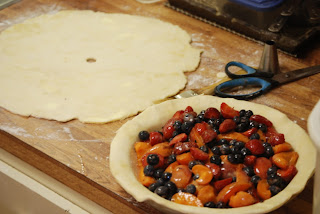The other day I saw a recipe for slow cooked green beans and
I thought that it could easily be applied for zucchini. Because it’s that time
of summer again--the attack of the killer zucchini. You know the type, the
giant, overgrown monsters from your Great Aunt Tessie’s garden. They arrive on
your front door steps in the dark of night like orphaned children, your well-meaning friends either overwhelmed by their
abundance of summer squash or simply out of ideas of what to do.
But this technique isn’t for those monsters. They’ve grown
too large, their seeds too big, the skins too tough. Those often end up stuffed
and baked. Or made into zucchini bread. At our local farmer’s market they are
everywhere, too, in all sizes spilling out of bushel baskets. It’s been that kind of year.
I like to select smaller-sized ones, about 5 to 7 inches
in length. I combine them with onion, garlic, tomatoes, basil and olive oil and
let them cook low and slow. It’s that simple. After about twenty minutes, they
yield easily to the point of a knife. A sprinkle of cheese is all you need to
finish them. Serve them in a bowl with the cooking liquid along with your
favorite protein and dinner is ready.
I have to go. More zucchini just walked in the front door.
Slow Cooked Summer Squash
While Mediterranean in inspiration, you could also season the squash with some chile powder, omit the basil and use chopped cilantro for a recipe that leans a little south-of-the-border.
For two servings
2 medium-sized zucchini or summer squash (about 5 to 7
inches each)
½ cup sliced onion
1 or 2 cloves garlic, sliced
1 medium tomato, chopped (1 cup) or 1 cup canned crushed
tomatoes
6 to 8 fresh basil leaves
salt and ground black pepper
olive oil, for cooking
¼ cup water
few tablespoons cheese (I used queso fresco because I had
some leftover in the 'fridge. Goat cheese or
another crumbling cheese or even
Parmesan or Romano would work)
1. Wash the zucchini. Cut off the top and bottom ends from
the squash. Slice the squash in half, lengthwise, then in half again. Carefully
run your knife the length of each piece to remove the softer, seed-bearing
part. Set aside.
2. Place a large sauté pan over medium-high heat. When hot,
swirl in 2 to 3 tablespoons olive oil. Add the onion and cook until the onion
begins to soften, about 2 to 3 minutes; do not brown the onions. Add the garlic
and cook until fragrant, about 30 seconds. Add the tomato; season with salt and
ground black pepper and stir together. Let tomatoes cook for two to three
minutes to soften and begin to give off juice. Lay the zucchini into the pan
skin side down. Season the squash with a little salt and pepper. Tear and
scatter the basil into the pan. Add the water. Cover the pan and lower the
heat. Let the zucchini simmer gently until completely tender, about twenty
minutes or so depending on the size of the squash. Before serving, taste and
adjust the seasoning if necessary. Scatter the cheese over the squash.
Carefully remove the zucchini from the pan and serve with the cooking liquid.





